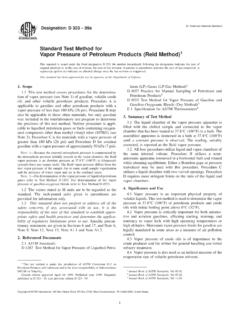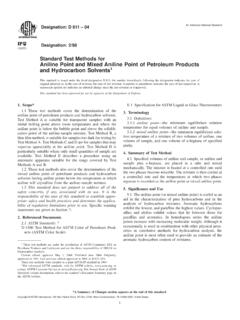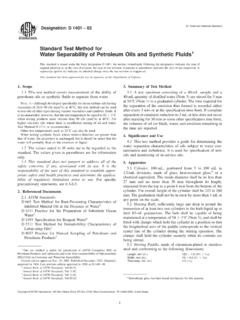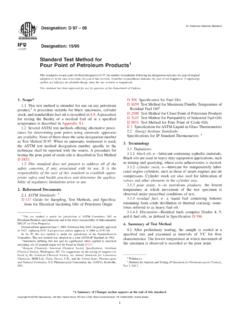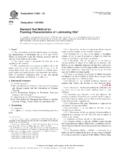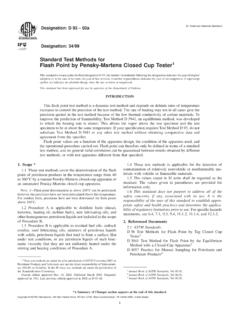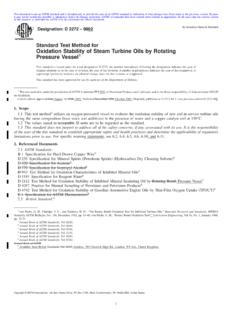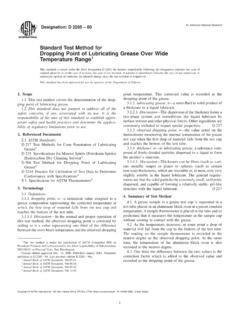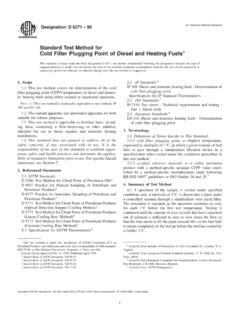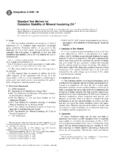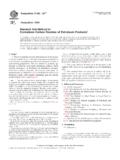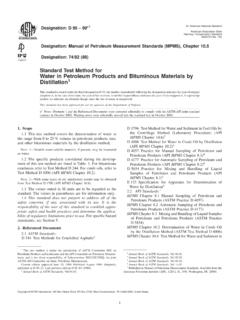Transcription of Standard Test Method for Distillation of Crude …
1 Designation: D 2892 03aAn American National StandardStandard Test Method forDistillation of Crude petroleum (15-Theoretical PlateColumn)1 This Standard is issued under the fixed designation D 2892; the number immediately following the designation indicates the year oforiginal adoption or, in the case of revision, the year of last revision. A number in parentheses indicates the year of last reapproval. Asuperscript epsilon (e) indicates an editorial change since the last revision or Scope* This test Method covers the procedure for the distillationof stabilized Crude petroleum (see Note 1) to a final cuttemperature of 400 C Atmospheric Equivalent Temperature(AET). This test Method employs a fractionating columnhaving an efficiency of 14 to 18 theoretical plates operated at areflux ratio of 5:1. Performance criteria for the necessaryequipment is specified. Some typical examples of acceptableapparatus are presented in schematic form.
2 This test methodoffers a compromise between efficiency and time in order tofacilitate the comparison of Distillation data between Defined as having a Reid vapor pressure less than kPa(12 psi). This test Method details procedures for the production ofa liquefied gas, distillate fractions, and residuum of Standard -ized quality on which analytical data can be obtained, and thedetermination of yields of the above fractions by both mass andvolume. From the preceding information, a graph of tempera-ture versus mass % distilled can be produced. This distillationcurve corresponds to a laboratory technique, which is definedat 15/5 (15 theoretical plate column, 5:1 reflux ratio) or TBP(true boiling point). This test Method can also be applied to any petroleummixture except liquefied petroleum gases, very light naphthas,and fractions having initial boiling points above 400 This test Method contains the following annexes Annex A1 Test Method for the Determination of theEfficiency of a Distillation Column, Annex A2 Test Method for the Determination of theDynamic Holdup of a Distillation Column, Annex A3 Test Method for the Determination of theHeat Loss in a Distillation Column (Static Conditions)
3 , Annex A4 Test Method for the Verification of Tem-perature Sensor Location, Annex A5 Test Method for Determination of theTemperature Response Time, Annex A6 Practice for the Calibration of Sensors, Annex A7 Test Method for the Verification of RefluxDividing Valves, Annex A8 Practice for Conversion of ObservedVapor Temperature to Atmospheric Equivalent Temperature(AET), Appendix X1 Test Method for Dehydration of aSample of Wet Crude Oil, Appendix X2 Practice for Performance The values stated in SI units are to be regarded asstandard. The values given in parentheses are provided forinformation Standard does not purport to address all of thesafety concerns, if any, associated with its use. It is theresponsibility of the user of this Standard to establish appro-priate safety and health practices and determine the applica-bility of regulatory limitations prior to specificwarning statements, see Section Referenced standards .
4 D 941 Test Method for Density and Relative Density (Spe-cific Gravity) of Liquids by Lipkin Bicapillary Pycnom-eter2D 1217 Test Method for Density and Relative Density(Specific Gravity) of Liquids by Bingham PycnometerD 1298 Test Method for Density, Relative Density (SpecificGravity), or API Gravity of Crude petroleum and LiquidPetroleum Products by Hydrometer MethodD 2427 Test Method for Determination of C2through C5 Hydrocarbons in Gasolines by Gas ChromatographyD 2887 Test Method for Boiling Range Distribution ofPetroleum Fractions by Gas ChromatographyD 3710 Test Method for Boiling Range Distribution ofGasoline and Gasoline Fractions by Gas ChromatographyD 4006 Test Method for Water in Crude Oil by DistillationD 4052 Test Method for Density and Relative Density ofLiquids by Digital Density Meter1 This test Method is under the jurisdiction of ASTM Committee D02 onPetroleum Products and Lubricants and is the direct responsibility of on edition approved Nov.
5 1, 2003. Published November 2003. Originallyapproved in 1970. Last previous edition approved in 2003 as D 2892 *A Summary of Changes section appears at the end of this ASTM International, 100 Barr Harbor Drive, PO Box C700, West Conshohocken, PA 19428-2959, United 4057 Practice for Manual Sampling of petroleum andPetroleum ProductsD 4177 Practice for Automatic Sampling of petroleum andPetroleum ProductsD 5134 Test Method for Detailed Analysis of PetroleumNaphthas throughn-Nonane by Capillary Gas Chromatog-raphy3. the condition in which there is no sig-nificant gain or loss of heat throughout the length of When distilling a mixture of com-pounds as is the case of Crude petroleum , there will be a normalincrease in reflux ratio down the column. In the case whereheat losses occur in the column, the internal reflux is abnor-mally greater than the reflux in the head.
6 The opposite is truewhen the column gains heat, as with an overheated rate the quantity of vapor entering the col-umn per unit of It is expressed in millilitres of liquidper hour for a given column or in millilitres per hour per squarecentimetre of cross-sectional area for comparative purposes. Inthe latter case, it refers to the test mixture ofn-heptane andmethylcyclohexane in the efficiency evaluation (see Annex A1)and is measured at the bottom of the column. The maximumboilup of then-heptane-methylcyclohexane test mixture is thatwhich the column can handle under stable conditions withoutflooding. In routine adiabatic operation, the boilup rate can beestimated roughly from the takeoff rate multiplied by the refluxratio plus of Crude petroleum the removal ofthe light hydrocarbons up to and includingn-butane, andretention of the heavier In practice, a Crude petroleum is re-garded as debutanized if the light hydrocarbon cut collected inthe cold trap contains more than 95 % of the C2to C4hydrocarbons and less than 5 % of the C5hydrocarbonsinitially present in the pressure the pressure measured as closeas possible to the point where the vapor temperature is taken.
7 Normally at the top of the temperature the temperature of the satu-rated vapor measured in the head just above the It is also known as the head tempera-ture or the vapor hold-up the quantity of liquid held up in thecolumn under normal operating It is expressed as a percentage of thepacked volume for packed columns so that the data can becompared. For real plate columns, it is expressed in millilitresper plate. The data can only be compared with others of thesame diameter because of different tray spacing. Data forpacked columns cannot be compared with those of real platecolumns except in absolute units of millilitres per theoreticalplate (see Table 1). Dynamic hold-up increases with increasingdistillation rate up to the flood point and varies from one kindof fractionator to point the point at which the velocity of theupflowing vapors obstructs the downcoming reflux and thecolumn suddenly loads with Under these conditions no vapor canreach the head and the heat to the Distillation flask must bereduced to establish normal operations again.
8 The flood point isnormally determined during the efficiency evaluation of acolumn using then-heptane-methylcyclohexane test mixture(see Annex A1). reflux the liquid normally running downinside the In the case of an adiabatic columnwhen distilling a pure compound, the internal reflux is constantfrom top to bottom and is equal to the reflux at the refluxdivider. When distilling Crude petroleum , the fractionationoccurring in the dynamic holdup will cause a temperaturegradient to be established with attendant greater amount ofinternal reflux at the bottom of the drop the difference between the pressuremeasured in the condenser and the pressure measured in thedistillation It is expressed in kilopascals (mm Hg)per metre of packed height for packed columns, or kilopascals(mm Hg) overall for real plate columns. It is higher foraromatics than for paraffins, and for higher molecular weightsthan for lighter molecules, at a given boilup ratio, R the ratio of reflux to The vapor reaching the top of thecolumn is totally condensed and the resulting liquid is dividedinto two parts.
9 One partL(reflux), is returned to the columnand the other part,D(distillate), is withdrawn as product. Thereflux ratio (R = L/D), can vary from zero at total takeoff(L=0) to infinity at total reflux (D=0). hold-up or wettage the quantity of liquidretained in the column after draining at the end of a It is characteristic of the packing orthe design of the plates, and depends on the composition of thematerial in the column at the final cut point and on the rate the rate of product takeoff from thereflux divider expressed in millilitres per plate the section of a column requiredto achieve thermodynamic equilibrium between a liquid and The height equivalent to one theoreti-cal plate (HETP) for packed columns is expressed in millime-tres. In the case of real plate columns, the efficiency isexpressed as the percentage of one theoretical plate that isachieved on one real Summary of Test A weighed sample of 1 to 30 L of stabilized crudepetroleum is distilled to a maximum temperature of 400 CAET in a fractionating column having an efficiency at totalreflux of at least 14, but not greater than 18, theoretical 2892 A reflux ratio of 5:1 is maintained at all operatingpressures, except that at the lowest operating pressures be-tween and kPa (5 and 2 mm Hg), a reflux ratio of2:1 is optional.
10 In cooperative testing or in cases of dispute, thestages of low pressure, the reflux ratios, and the temperaturesof cut points must be mutually agreed upon by the interestedparties prior to beginning the Observations of temperature, pressure, and other vari-ables are recorded at intervals and at the end of each cut The mass and density of each cut or fraction areobtained. Distillation yields by mass are calculated from themass of all fractions, including liquefied gas cut and theresidue. Distillation yields by volume of all fractions and theresidue at 15 C are calculated from mass and From these data the TBP curves in mass or volume %,or both, versus AET are Significance and This test Method is one of a number of tests conductedon a Crude oil to determine its value. It provides an estimate ofthe yields of fractions of various boiling ranges and is thereforevaluable in technical discussions of a commercial This test Method corresponds to the Standard laboratorydistillation efficiency referred to as 15/5.
